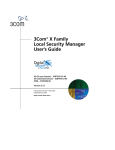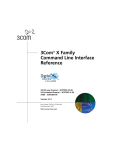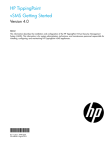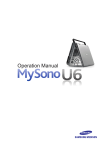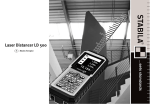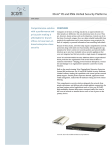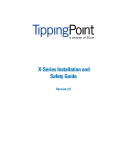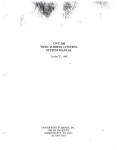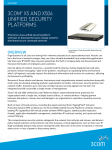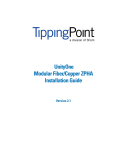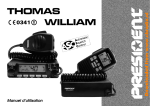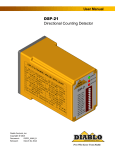Download HP X Unified Security Platform Series Installation Manual
Transcript
X Family of Security Devices Hardware Installation Guide Version 2.5.1 ■ X5 ■ X506 Part Number TECHD-220 Rev A01 Published April 2007 http://www.3com.com/ 3Com Corporation 350 Campus Drive Marlborough, MA 01752-3064 Copyright © 2006–2007, 3Com Corporation. All rights reserved. No part of this documentation may be reproduced in any form or by any means or used to make any derivative work (such as translation, transformation, or adaptation) without written permission from 3Com Corporation. 3Com Corporation reserves the right to revise this documentation and to make changes in content from time to time without obligation on the part of 3Com Corporation to provide notification of such revision or change. 3Com Corporation provides this documentation without warranty, term, or condition of any kind, either implied or expressed, including, but not limited to, the implied warranties, terms, or conditions of merchantability, satisfactory quality, and fitness for a particular purpose. 3Com may make improvements or changes in the product(s) and/or the program(s) described in this documentation at any time. If there is any software on removable media described in this documentation, it is furnished under a license agreement included with the product as a separate document, in the hardcopy documentation, or on the removable media in a directory file named LICENSE.TXT or !LICENSE.TXT. If you are unable to locate a copy, please contact 3Com and a copy will be provided to you. UNITED STATES GOVERNMENT LEGENDS: If you are a United States government agency, then this documentation and the software described herein are provided to you subject to the following: United States Government Legend: All technical data and computer software is commercial in nature and developed solely at private expense. Software is delivered as Commercial Computer Software as defined in DFARS 252.227-7014 (June 1995) or as a commercial item as defined in FAR 2.101(a) and as such is provided with only such rights as are provided in 3Com’s standard commercial license for the Software. Technical data is provided with limited rights only as provided in DFAR 252.227-7015 (Nov 1995) or FAR 52.227-14 (June 1987), whichever is applicable. You agree not to remove or deface any portion of any legend provided on any licensed program or documentation contained in, or delivered to you in conjunction with guide. Unless otherwise indicated, 3Com registered trademarks are registered in the United States and may or may not be registered in other countries. 3Com and the 3Com logo are registered trademarks of 3Com Corporation. TippingPoint, the TippingPoint logo, and Digital Vaccine are trademarks of 3Com Corporation or one of its subsidiaries. Microsoft and Windows are either registered trademarks or trademarks of Microsoft Corporation in the United States and/or other countries. Oracle is a registered trademark of Oracle Corporation. Other brand and product names may be registered trademarks or trademarks of their respective holders. Contents Contents About This Guide Overview Target Audience Organization Conventions Headings Typeface Cross-References Messages Warning Caution Note Tip Related Documentation Customer Support Contact Information Chapter 1. Prepare the Site Overview Safety Requirements Class A Notices Class B Notices General Guidelines Environmental Requirements System Grounding Requirements Unpack the System Chapter 2. Overview Overview X Family Overview Core Functionality X Family Environment Optimized VPN Connectivity Policy Enforcement Security Zones and Network Interfaces IPS Threat Suppression Engine Local Security Manager Security Management System Threat Management Center 5 5 5 6 7 7 7 7 7 7 8 8 8 9 9 9 11 11 12 12 12 13 15 15 16 17 17 17 18 18 19 19 19 20 20 21 21 21 X Family of Security Devices Hardware Installation Guide V 2.5.1 3 Contents Chapter 3. 3Com X5 Overview Overview Chassis Overview LEDs Technical Specifications Hardware Specifications Technical Specifications Software Specifications Hardware Installation and Configuration Determine Installation Location Connect the Power Complete Initial Setup Configuration Connect the X5 to the Internet Register the X5 Device Troubleshooting the X5 Device Cannot Access Device Through LAN Port Chapter 4. 3Com X506 Overview Overview Chassis Overview Chassis Features LEDs Technical Specifications Hardware Specifications Technical Specifications Software Specifications Hardware Installation and Configuration Install the X506 Chassis Determine Total Rack Space Bolt the Device to the Rack Connect the Power Complete Initial Setup Configuration Connect the X506 Device to the Internet Register the 3Com X506 Device Troubleshooting the X506 Device Cannot Access Device Through LAN Port 23 23 24 24 25 25 26 26 27 27 27 27 28 28 29 29 31 31 32 32 32 33 33 34 34 35 35 35 35 36 36 37 37 37 38 Appendix A. Connector and Pinout Specifications 39 Port Connectors X5 and X506 Port Connectors Additional X506 Connectors 4 X Family of Security Devices Hardware Installation Guide V 2.5.1 39 39 40 About This Guide Explains who this book is intended for, how the information is organized, where information updates can be found, and how to obtain customer support if you cannot resolve a problem. Overview Welcome to the X Family of Security Devices Hardware Installation Guide. The 3Com X Family of security devices combines firewall and VPN functionality with the Intrusion Prevention System (IPS) to provide a unified approach to network security. The Local Security Manager (LSM) and Security Management System (SMS) provide management options for your X Family devices and network security. This chapter includes the following sections: • • • • • “Target Audience” on page 5 “Organization” on page 6 “Conventions” on page 7 “Related Documentation” on page 9 “Customer Support” on page 9 Target Audience This guide is intended for use by technicians and maintenance personnel responsible for installing, configuring, and maintaining the X Family devices. Users should be familiar with telecommunications products and networking concepts. X Family Hardware Installation Guide V 2.5.1 5 About This Guide Organization The X Family of Security Devices Hardware Installation Guide is organized as follows: • About the Guide — Explains who this book is intended for, how the information is organized, where information updates can be found, and how to obtain customer support if you cannot resolve a problem. • X Family Overview — Provides a description of the deployment environment of the X Family devices, including layout and illustrations of hardware components and features. • Prepare the Site — Provides general requirements for the installation site and guidelines for electrical and network connections. For specific requirements, review the chapter according to device model. • X5 Overview — Provides a description of the deployment environment of the X5 device, including layout and illustrations of hardware components and features. • X506 Overview — Provides a description of the deployment environment of the X506, including layout and illustrations of hardware components and features. • Appendix A: Connector and Pinout Specifications — Provides connector and pinout information for the X Family devices. 6 X Family of Security Devices Hardware Installation Guide V 2.5.1 Conventions Conventions This book and the other books in this series follow conventions for structuring information as described next. Headings Every chapter starts with a brief description of the information that you can find in that chapter, which correlates with the major headings in that chapter. Each major heading corresponds to a task or concept that is important for you to understand. Headings are of a different size and type to make them easy to skim, whether you are viewing an online or print copy of this document. Typeface This book uses the following typeface conventions: Bold Code Italic Hyperlink Used for the names of screen elements like buttons, drop-down lists, or fields. For example, when you are finished with a dialog box, you click the OK button. Used for text that the user must type to use the product. Used for book titles, variables, and important terms. Used for web site and cross-reference links. Cross-References When a topic is covered in depth elsewhere in this guide or in another book in this series, a crossreference to the other information will be provided. Cross-references within this book take this form: “For more information about conventions, see page 6, Conventions.” Cross-references to other publications take this form: “For more information about <topic>, see Publication Name.” Messages Messages are special text that are emphasized by font, format, and icons. 3Com documents have four types of messages: • • • • Warning Caution Note Tip A description of each message type with an example message follows. Warning Warnings tell you how to avoid physical injury to people or equipment. For people, injury includes anything from temporary conditions, such as pain, to irreversible conditions such as death. For equipment, injury means anything requiring repair. Warnings tell you what you should or should not do, and the consequences of not heeding the warning. X Family of Security Devices Hardware Installation Guide V 2.5.1 7 About This Guide Warnings have an icon to the left showing a white lightning bolt drawn inside of a red octagon. Warnings also start with the word “WARNING” and are presented in boldface type. WARNING: Only trained and qualified personnel should install, replace, or service this equipment. Disconnect the system before servicing. Caution Cautions tell you how to avoid a serious loss that stops short of physical damage such as the loss of data, time, or security. Cautions tell you what you should or should not do to avoid such losses, and the consequences of not heeding the caution. Cautions have an icon to the left showing a black exclamation point drawn inside of a yellow triangle. Cautions also start with the word “CAUTION”. CAUTION: Do not type del *.* from the root (C:\) directory. Typing del *.* from the root directory will destroy all the program and configuration data that your computer needs to run, and will render your system inoperable. Note Notes tell you about information that might not be obvious, or that does not relate directly to the current topic, but that may affect relevant behavior. A note has an icon to the left showing a piece of note paper, and starts with the word “Note”. Note: Most car rental companies no longer allow cash deposits in lieu of a credit card when renting a car. Non-credit card deposits can only be arranged by a lengthy application and approval process. Tip Tips are suggestions about how you can perform a task more easily or more efficiently. A tip has an icon to the left showing a light bulb drawn inside and starts with the word “Tip.” Tip: Setting the logging parameter to “off” or “minimal” will improve your system’s processing performance, but it will make debugging very difficult in the event of a system crash. During system integration, you can set logging to “full” to ease debugging. After you have finished testing, set logging to “minimal” to improve performance. 8 X Family of Security Devices Hardware Installation Guide V 2.5.1 Related Documentation Related Documentation The X Family devices have a full set of documentation. These publications are available in electronic format on your Documentation CDs. For the most recent updates and for Release Notes, visit www.3com.com Customer Support 3Com is committed to providing high-quality customer support to all of its customers. A customer is provided with detailed customer and support contact information. For the most efficient resolution of your problem, please take a moment to gather some basic information from your records and from your system before you contact 3Com customer support. Information Location Your X Family serial number You can find this number in the LSM in the System Summary page, on the shipping invoice that came with your X Family system, or on the bottom of the device. Your TOS version number You can find this information in the LSM in the System Summary page, or by using the CLI show version command. Your X Family device system boot time You can find this information in the LSM in the System Summary page. Contact Information Please address all questions regarding the 3Com software to your authorized 3Com representative. For customer support contact information, refer to the release notes that ship with your device. X Family of Security Devices Hardware Installation Guide V 2.5.1 9 About This Guide 10 X Family of Security Devices Hardware Installation Guide V 2.5.1 1 Prepare the Site This chapter discusses the general requirements necessary to prepare your site for the installation of the 3Com X Family device. Overview Before you install your new 3Com X Family security device, you need to gather materials and prepare the network and hardware site. To carefully and correctly install the components, you must read through all preparation instructions and requirements. This chapter includes general guideline information for all devices in the family. This chapter covers these topics: • • • • “Safety Requirements” on page 12 “Environmental Requirements” on page 15 “System Grounding Requirements” on page 15 “Unpack the System” on page 16 3Com X Family Hardware Installation Guide 11 Chapter 1: Prepare the Site Safety Requirements If not properly installed and maintained, electrical circuitry equipment like the 3Com X Family devices can pose dangers to both personnel and equipment. To prevent accidents, adhere to the following guidelines to ensure general safety: • Remove any dust from the area and keep the area around the 3Com X Family system clear and dustfree during and after installation. • Wear safety glasses if you are working under conditions that might be hazardous to your eyes. • There are no serviceable parts inside the chassis. Class A Notices The X506 is a Class A device. Read and follow all of the notices and safety instructions in the document called 3Com Hardware Compliance X Family Class A Notice, which is shipped in the box with the X506. Class B Notices The X5 is a Class B device. Read and follow all of the notices and safety instructions in the document called Regulatory Information for the 3Com X5 Security Device, which is shipped in the box with the X5. 12 3Com X Family Hardware Installation Guide Safety Requirements General Guidelines Read and follow these cautions and warnings for further safety guidelines. CAUTION: Before you start the installation procedures, read this entire chapter for important information and safety warnings. Use proper electrostatic discharge (ESD) protection when you handle equipment. Do not power up the equipment while you install and connect the system. For rack-mountable equipment, the equipment rack must be anchored to an unmovable support to prevent it from falling over when one or more servers are extended in front of it on slide assemblies. The equipment rack must be installed according to the manufacturer’s instructions. You must also consider the weight of any other device installed in the rack. For rack-mountable equipment, you are responsible for installing an AC power disconnect for the entire rack unit. This main disconnect must be readily accessible, and it must be labeled as controlling power to the entire unit, not just to the server. Make sure that the chassis cooling fans run continuously while the system is powered. Use of controls or adjustments or performance of procedures other than those specified herein may result in hazardous radiation exposure. 3Com X Family Hardware Installation Guide #13 Chapter 1: Prepare the Site WARNING: Only trained and qualified personnel should install, replace, or service this equipment. Disconnect the system before servicing it. There are no user-replaceable parts in the chassis. This product requires short-circuit (overcurrent) protection to be provided as part of the building installation. Install only in accordance with national and local wiring regulations. Do not operate the system unless top cover is in place. To reduce the risk of fire, use only No. 26 AWG or larger telecommunication line cord. The battery in this unit is not replaceable. There is a risk of explosion if the battery is replaced by an incorrect type. Dispose of used batteries according to the instructions. This equipment is to be installed and maintained by service personnel only as defined by AS/NZS 3260 Clause 1.2.14.3 Service Personnel. This unit is intended for installation in restricted access areas only. When connecting equipment to IT power distributions, Phase to phase voltage must not exceed 240 V. The ports on the front of the 3Com X Family devices are Safety Extra-Low Voltage (SELV) circuits. SELV circuits should only be connected to other SELV circuits. Do not work on the system or connect or disconnect cables during periods of lightning activity. To prevent the unit from overheating, do not operate it in an area that exceeds the maximum recommended ambient temperature of 104° F (40° C). To prevent airflow restriction, allow at least 3 inches (7.6 cm) of clearance around the ventilation openings. 14 3Com X Family Hardware Installation Guide Environmental Requirements WARNING: Read all of the installation instructions before you connect the system to its power source. Never touch uninsulated telephone wires or terminals unless the telephone line has been disconnected at the network interface. Do not operate the system unless all faceplates and covers are in place. Faceplates and cover panels serve three important functions: They prevent exposure to hazardous voltages and currents inside the chassis; they contain electromagnetic interference (EMI) that could disrupt other equipment; and they direct the flow of cooling air through the chassis. To prevent personal injury or damage to the chassis, lift the chassis from beneath its lower edge. For rack-mountable equipment, enclosed racks may have higher ambient temperatures than open racks. Ensure that enclosed racks’ ambient temperatures do not exceed maximum recommended ambient temperature of 104 °F (40 °C). Environmental Requirements In order for the 3Com X Family device to run properly, your environment must meet the proper criteria. The following table lists the recommendations for temperature, humidity, and altitude settings for the Service Provider (SP) environment. Table 1 - 1: Environmental Requirements for the 3Com X Family Environmental Specifications Description Temperature 0 to 40 ° C (32 to 104 ° F) — Operating -20 to 80° C (-4 to 176 ° F) — Storage Humidity 5 to 95% (non-condensing) Altitude No degradation up to 13K feet above sea level System Grounding Requirements Damage from electrotatic discharge (ESD) can occur when electronic components are improperly handled. This damage can result in complete or intermittent system failures. Proper ESD protection is required whenever you handle equipment. It is not necessary to open the chassis to add or remove any components. The unit has no replaceable parts inside it. 3Com X Family Hardware Installation Guide #15 Chapter 1: Prepare the Site Unpack the System Each system chassis is securely packaged in a shipping box. CAUTION: ESD can damage the 3Com X Family device if you do not take necessary precautions. Installation and maintenance personnel should be properly grounded using ground straps to eliminate the risk of ESD damage to the equipment. Use caution when opening the 3Com X Family boxes. To unpack the 3Com X Family device STEP 1 Inspect the packing container. If you see any damage or other signs of mishandling, inform both the local freight provider and 3Com before you unpack the device. Your freight provider can provide you with the procedures necessary to file a claim for damages. STEP 2 Carefully open the box. STEP 3 Remove all packing material. STEP 4 Verify the contents in the shipping package. Compare the packing list to your shipment and to your order. If items are missing, contact your sales or field representative. STEP 5 Remove the chassis from the box. STEP 6 Open the accessory kit. It contains the cables, documentation, and Documentation CD. STEP 7 Inspect all the equipment inside for damage. If you think any equipment might be damaged, contact your freight provider for how to lodge a damage claim and contact your sales or field representative for instructions. Please Recycle: The shipping materials are recyclable. Please save them for later use or dispose of them appropriately. 16 3Com X Family Hardware Installation Guide 2 Overview This chapter introduces system concepts and functionality. It provides an overview of the X Family. Overview In the highly technical era of data transfers and the Internet, the protection of data and networks concerns most businesses, corporations, and network administrators. 3Com has studied the issue of data security and network protection from malicious activity and attacks. One of the solutions is the X Family of security devices (X Family). The X Family devices provide constant vigilance for a network by monitoring and managing packets while blocking malicious attacks. This chapter covers these topics: • “X Family Overview” on page 17 • “X Family Environment” on page 18 X Family Overview The X Family of security devices combines virtual private network (VPN) management, stateful packet inspection firewall, bandwidth management, and web content filtering with the Intrusion Prevention System (IPS). The IPS provides total packet inspection and intrusion prevention. The IPS detects and blocks inappropriate, incorrect, or anomalous activity on the network by comparing network traffic with filters defined by the 3Com TippingPoint Division. The X Family devices use filters to scan traffic and recognize header or data content in the attack along with the protocol, service, and the operating system or software that the attack affects. The attack filter includes an action set, which defines the reaction when the X Family device encounters packets that match attack filter parameters. In a broad sense, the X Family device either drops matching packets or permits them. The Stateful firewall provides service-level, stateful inspection of network traffic before it is inspected by the IPS. It incorporates filtering functionality to protect mission-critical applications. An X Family Hardware Installation Guide V 2.5.1 17 Chapter 2: Overview administrator can use firewalls and content filters that determine how the system handles traffic to and from a particular service. These filters are specified by the source, destination, and service or protocol of the traffic. Network Address Translation (NAT) provides the capability to share a single IP address, or to define Virtual Servers for public services such as web sites. Core Functionality The X Family device provides the following core functionality: • Optimized VPN connectivity — The device allows inspection and control of traffic both inside and outside of VPN tunnels. • Enforcement of usage policies — The device can be used to rate-limit applications, such as peer-topeer file sharing applications. It includes an optional Web Content Filter subscription service. for preventing access to undesirable Web sites. • Multicast applications — The device prioritizes real-time traffic and provides secure connectivity for IP multicast traffic. • Detection and suppression — Unlike an intrusion detection system (IDS), the device identifies and stops malicious traffic on the edge of the network. • Filter customization — Through IP filters, exceptions, and attack filter creation, you can customize the system to meet the specific needs of your enterprise. • Real-time threat aggregation — The TMC collects threat information from throughout the world, converts it to attack filters, and distributes it to customers. • Monitoring — The integrated reports generated by the device show graphically what traffic is going through the device to what servers. This includes visibility on web site access and type of traffic being transferred. • Dynamic routing —The device can participate in dynamic routing via RIPv1/RIPv2 or static routes. • Central management and reporting via the TippingPoint Security Management System (SMS) — available separately. SMS allows bulk configuration of all features of the device, including easy creation of VPN tunnels. SMS also offers centralized report generation and log collation. The following sections describe each security application in more detail. X Family Environment A single X Family device can be installed at the perimeter of your network, on your Intranet, or both. All of the functionality of the devices runs directly on the device as the Operating System (TOS). The Local Security Manager (LSM) is a web-browser client for managing your device that provides a graphical interface for on-the-box administration, configuration, and reporting. The LSM accesses the functionality of the X Family TOS. You can also access the functionality of the device using the Command Line Interface (CLI). The CLI provides a way for you to set values, run setup commands, and perform general functions. However, the LSM provides most of the same functionality, except for some advanced configuration commands. In addition the LSM provides reporting and filter configuration. 18 X Family Hardware Installation Guide V 2.5.1 X Family Environment The Security Management System (SMS) provides functionality beyond that provided by the LSM and CLI. The SMS enables you to manage not one but multiple devices. The SMS coordinates all X Family and IPS devices across your environment for administration, configuration, and monitoring. Most important, the SMS includes enterprise-wide reporting and trend analysis. From the SMS, you must set an overall profile of settings for each X Family device. The profile controls how the device responds to traffic that matches filters. The X Family device is always in Active mode and reacts to traffic as specified by the appropriate filter. The LSM and the X Family device maintain a connection to the Threat Management Center (TMC), which is located at TippingPoint headquarters. The TMC monitors 10,000 sensors around the world for the latest attack information. As a result, your network can be continually inoculated. Each component of the X Family environment is discussed in more detail in the following sections. Additional information about the X Family devices is available in the X Family Concepts Guide. Optimized VPN Connectivity The X Family VPN features support IPSec, L2TP, and PPTP tunneling protocols, as well as DES, 3DES, AES-128/192/256, MD5, and SHA-1 encryption standards, and manual keyring, IKE with pre-shared keys, and IKE with X.509 certificates. The device provides intrusion prevention inspection within VPN tunnels and can also prioritize traffic bi-directionally, both inside and outside of the VPN tunnels. The VPN is hardware-accelerated, with an ASIC designed specifically for encrypting and decrypting packets. To increase network security, you can configure VPN traffic to terminate in a security zone that is separate from your internal LAN security zones. The X Family devices also support NAT deployment within VPN tunnels. Policy Enforcement Policy enforcement includes the X Family device firewall, content filtering, and the IPS. The X Family device has a stateful inspection firewall with a top-down rule evaluation engine. The firewall can be used to rate-limit both security zones and applications, preventing excess bandwidth consumption. 3Com offers a Web Filtering subscription service, which allows or denies web sites by category. You can also manually allow or block URLs as exceptions to the defined rules. Web Filtering is applied through firewall rules. Security Zones and Network Interfaces Security Zones enable you to segment your network into trusted areas. Traffic within a security zone is switched at wire speed and is not inspected. Traffic between two security zones is inspected by the firewall, IPS, and other security services. A security zone can be associated with one or more physical ports or can exist only virtually by logical definition (no ports). A virtual zone is useful for terminating VPNs such that traffic can be inspected within the VPN tunnel after decryption as part of routing to the destination security zone. Policy enforcement is applied to traffic that moves between security zones. Network virtual interfaces enable you to connect multiple Layer 3 networks to the X family device. Each Security Zone needs to be associated with a Virtual Interface. A Virtual Interface can be associated with multiple security zones in a transparent/bridged deployment where security is still enforced but the device is deployed easily into an existing Layer 2 network. Security zones can be defined through 802.1q VLAN tags. X Family Hardware Installation Guide V 2.5.1 19 Chapter 2: Overview IPS X Family devices use the IPS to protect your network by scanning, detecting, and responding to network traffic according to the filters, action sets, and global settings maintained on each device by a client. Each device provides intrusion prevention for your network according to the amount of network connections and hardware capabilities. The IPS is designed to handle the extremely high security demands of carriers and high-density data centers. This functionality has been scaled down into the X Family, providing unprecedented attack prevention for smaller deployments. Even while under attack, Intrusion Prevention Systems are extremely low-latency network infrastructure ensuring switch-like network performance. The IPS is an active network defense component that uses the Threat Suppression Engine (TSE) to detect and respond to attacks. Intrusion Prevention Systems are optimized to provide high-resiliency, high-availability security for remote branch offices, small-to-medium and large enterprises, and collocation facilities. Each system can protect network segments from both external and internal attacks. X Family devices provide the following Ethernet interfaces and traffic performance: Table 2 - 1: X Family System Performance Ethernet interfaces Model Concurrent sessions IPS Performance Firewall Performance Triple DES X5, 25-user license 6 x 10/100 20,000 18 Mbps 50 Mbps 40 Mbps X5, unlimited-user license 6 x 10/100 60,000 18 Mbps 50 Mbps 40 Mbps X506 6 x 10/100 128,000 50 Mbps 100 Mbps 95 Mbps Threat Suppression Engine The Threat Suppression Engine (TSE) is a highly specialized, hardware-based intrusion prevention platform. The TSE is a high-performance software engine that contains all the functions needed for Intrusion Prevention, including IP defragmentation, TCP flow reassembly, statistical analysis, traffic shaping, flow blocking, flow state tracking, and application-layer parsing of over 170 network protocols. The TSE reconstructs and inspects flow payloads by parsing the traffic at the application layer. As each new packet of the traffic flow arrives, the engine reevaluates the traffic for malicious content. The instant the engine detects malicious traffic, it blocks all current and all subsequent packets pertaining to the traffic flow. The block of the traffic and packets ensures that the attack never reaches its destination. The highly specialized traffic classification engines enable the IPS to filter with extreme accuracy. 20 X Family Hardware Installation Guide V 2.5.1 X Family Environment Local Security Manager The Local Security Manager (LSM) is responsible for local administration, configuration, and reporting for a single X Family device. Through a graphical user interface (GUI), the LSM provides the interfaces, tools, and processes that configure and monitor the X Family device. The LSM provides a subset of the management functionality offered through the Security Management System, which is designed to manage several X Family units from a central server. You access the LSM through a web browser (Internet Explorer V6 or Firefox). The application accesses the Operating System and settings stored on the device. Through the LSM, you can manage settings directly to the device. You access each device to use the LSM. The LSM is not a central application that accesses each device in turn. Rather, it resides as a graphical client for managing the device. For more detailed information, see the Local Security Manager User’s Guide. Security Management System The Security Management System (SMS) provides a global view and control for the X Family environment. It is shipped as a management server and includes an enterprise desktop — the workstation client — through which end users can perform secure, policy-based management tasks for multiple X Family devices. It provides facilities similar to the LSM but supports a larger scope. Most important, it provides enterprise-wide reporting. Unlike the LSM, the SMS client provides a central application for managing multiple X Family devices. You can create multiple profiles of firewall rules, IPS filters, VPNs, and more to distribute to specific devices organized in segment groups. You can also update the TOS software updates, Digital Vaccine packages, and configuration settings for all devices through the SMS. For more detailed information, see the TippingPoint Security Management System User’s Guide on the Documentation CD that is shipped with your X Family device. Threat Management Center The Threat Management Center (TMC) is the central intelligence bureau for the X Family environment. The TMC performs comprehensive global reconnaissance for emerging threats. It rapidly builds new filters and algorithms to suppress such threats. The TMC offers the following end-user services: • Digital Vaccine — A subscription service that offers real-time continuous update capability. With Digital Vaccine, the X Family devices pull new threat filters from the TMC on a routine basis. • Software Updates — Upgraded and updated versions of the software that you can use for your X Family device, including the Local Security Manager and Security Management System • Technical Support — Information on how to contact 3Com and receive technical support for user issues X Family Hardware Installation Guide V 2.5.1 21 Chapter 2: Overview 22 X Family Hardware Installation Guide V 2.5.1 3 3Com X5 Overview This chapter provides an overview of the X5 device. Overview This chapter describes the components, chassis, requirements, and installation of the X5 device. Before you install the X5 device, read the Quick Start Guide for the X5 (which is shipped in the box with the unit) and download the X Family Command Line Interface Reference from the Documentation CD that is shipped with the unit. After you install the components, you must run the Setup Wizard as part of the installation and configuration procedures. This chapter includes the following topics: • “Chassis Overview” on page 24 • “Technical Specifications” on page 25 • “Hardware Installation and Configuration” on page 27 X Family Hardware Installation Guide 23 Chapter 3: 3Com X5 Overview Chassis Overview The X5 comprises a compact chassis that does not require installation on a server rack. The X5 uses a front-access, 6-port architecture, supporting connections to up to 16 network security zones. The following image shows the front chassis interface for the X5 device. Figure 3 - 1: X5 - Front Panel Power Adapter Input COM Port LAN Port WAN Port Status LEDs LEDs The following table describes the Status LEDs. Table 3 - 1: Status LED Descriptions LED Color Top LED Flashing Booting Indicates that the X5 is booting up Solid green Operational Indicates that the X5 is online Flashing Establishing VPN Indicates that the VPN connection is in the process of being established Solid green Operational Indicates that all configured VPN connections are established successfully Solid green, slow flash Established with traffic Indicates that the established VPN connections are passing data traffic Bottom LED 24 State X Family Hardware Installation Guide Description Technical Specifications The following table describes the Link and Activity LEDs that are at the upper left and right corners of each Ethernet port. Table 3 - 2: Ethernet Port LED Descriptions LED Activity LED Link Color State Description No light No traffic Indicates that the port is not ready and is not passing traffic, or is malfunctioning Blinking amber Operational Indicates that the port is passing data No light No traffic Indicates that the link is not active Green Operational Indicates that the link is active Technical Specifications The following sections describe the hardware, technical, and software specifications for the X5. • “Hardware Specifications” on page 25 • “Technical Specifications” on page 26 • “Software Specifications” on page 26 Hardware Specifications The following table lists hardware specifications for the X5. Table 3 - 3: X5 Specifications Specification Description Dimensions 11.5 in. x 6.6 in. x 1.8 in (29 cm x 17 cm x 4 cm) Weight 3.25 lb (1.21 kg) Serial Interface RJ45 interface: COM1; 115200 baud; parity: none Network Interfaces 6 copper ports Power Requirements 100 to 240 VAC; 0.8-0.4 amperes @ 50-60 Hz; maximum power consumption: 30 Watts X Family Hardware Installation Guide V2.5.1 25 Chapter 3: 3Com X5 Overview Table 3 - 3: X5 Specifications Specification Service Provider operating requirements Description Temperature Operating: 0 to 40 ° C (32 to104 ° F) Storage: –20 to 70° C (–4 to 158° F) Altitude No degradation up to 13K feet Humidity 5% to 95% (noncondensing) Note: Use only the supplied wall-mounted power supply. Do not use other power supplies with the X5 device. Technical Specifications The following table lists technical specifications. Table 3 - 4: X5 Hardware Specifications Specification Detail Description Power consumption Max 30W External interfaces Six 10/100 Ethernet one RJ45 serial Software Specifications To configure the X5 device you need one of the following software applications or devices. Table 3 - 5: Configuration Requirements for the X5 Device 26 Specification Description X Family Security Management System (SMS) Software, Version 2.5 and above. (optional) SMS can optionally be used to manage multiple Intrusion Prevention Systems. 1 Windows-based PC running Windows 9x, NT, 2000, XP, or ME Must be attached to your network via PC serial port. X Family Hardware Installation Guide Hardware Installation and Configuration Hardware Installation and Configuration This section includes the following topics: • • • • • “Determine Installation Location” on page 27 “Connect the Power” on page 27 “Complete Initial Setup Configuration” on page 27 “Connect the X5 to the Internet” on page 28 “Register the X5 Device” on page 28 Determine Installation Location The X5 is a compact device that does not require rack installation. Place it in a location with adequate ventilation. Do not block or cover it with any other devices or objects. Connect the Power The X5 includes a 5V DC power supply. Use only the supplied power supply. Do not use other power supplies with the X5 device. STEP 1 Plug the power supply into the input connector on the front of the X5 device. STEP 2 Plug the power supply into an AC outlet, power strip, or UPS. CAUTION: The X5 device may take several minutes to boot up. When the Status LED is steady green, the device is powered up and ready to use. Complete Initial Setup Configuration STEP 1 Configure your computer’s network connection to receive an IP address by DHCP. STEP 2 Use an Ethernet cable to connect your computer directly to the X5 LAN port. Your computer will receive an IP address from the X5 device. STEP 3 In your PC’s internet browser, connect to the X5 default LAN address (https://192.168.1.254). STEP 4 The OBE wizard opens. Take these steps: STEP A Accept the default security level of Level 2. STEP B Specify the SuperUser account information at the prompt: STEP C • User Name • Password • Confirm password Accept the default settings in the rest of the Setup Wizard: Select No at the prompt. STEP D Depending on your internet connectivity, you may need to update your WAN settings in the Virtual Interfaces setup screen. X Family Hardware Installation Guide V2.5.1 27 Chapter 3: 3Com X5 Overview STEP E • If you use DHCP to connect to your Internet provider, accept the default WAN settings. • If you use PPPoE, enter your ISP user name and password. • If your ISP assigns a static IP address, select Static as the external interface type and enter the IP address, subnet mask, and default gateway information. Define additional user accounts if desired. At this point, your initial configuration of the X5 is complete. You can now use the LSM to change settings in the future. Note: When you connect to the LAN address, your browser may display a security certificate warning. Accept the certificate and continue with the configuration procedure. Connect the X5 to the Internet STEP 1 Use an Ethernet cable to connect the X5 WAN port to your router. If the X5 is configured to receive its WAN IP address by DHCP, PPPoE, PPTP, or L2TP, the device connects to your service provider. This may take a minute or more. STEP 2 Check the status of the external virtual interface with the LSM or the CLI. If active, the interface will be in “Up” status and will have an IP address. STEP 3 Use your web browser to connect to an external URL, such as http://www.3com.com If you can see the web site, your internet connection is active, and you can register your device and configure other features of the X5. Register the X5 Device To activate your license, you must register the X5 device on the 3Com eSupport Web site ((http://esupport.3com.com). Have the following information available: • Product code. — 3CRTPX5-U-96 for unlimited user licenses. — 3CRTPX5-25-96 for 25-user licenses. • Serial number. You can find the serial number: — in the Local Security Manager (LSM), on the System Summary page. — with the Command Line Interface (CLI) show version command. — on the bottom of the X5 unit, on the bar code sticker. • Product purchase information: — Company Purchased From — Purchase Location City — Warranty Start Date, in the format mm/dd/yyyy • Digital Vaccine license key. 28 X Family Hardware Installation Guide Troubleshooting the X5 Device Troubleshooting the X5 Device This section describes procedures for troubleshooting your X5 device. Cannot Access Device Through LAN Port STEP 1 Check the LAN port LEDs. If the green Link LED is off, the port is not active. Check that you are connected to port 1 (LAN) on the device. STEP 2 Check that your PC has received an IP address from the device. This will be in the range 192.168.1.1 to 192.168.1.20. If not, check that your PC is configured for DHCP IP address allocation. STEP 3 Try to ping the device from the PC at address 192.168.1.254. If the device responds, then it is booted and running. If none of the above steps help, then contact 3Com Technical Support. X Family Hardware Installation Guide V2.5.1 29 Chapter 3: 3Com X5 Overview 30 X Family Hardware Installation Guide 4 3Com X506 Overview This chapter provides an overview of the 3Com X506 security device. Overview This chapter describes the components, chassis, requirements, and installation of the 3Com X506 security device. Prior to installation, you should also obtain the 3Com X Family Command Line Interface Reference. After you install components, you must run through the Setup Wizard as part of the installation and configuration procedures. This chapter includes the following topics: • “Chassis Overview” on page 32 • “Technical Specifications” on page 33 • “Hardware Installation and Configuration” on page 35 X Family Hardware Installation Guide V 2.5.1 31 Chapter 4: 3Com X506 Overview Chassis Overview The 3Com X506 system comprises a 1-rack-unit chassis with a front-access architecture. The X506 has 6 ports, supporting up to 6 network segments. It is rack-mountable on a 19- or 23-inch rack. The following image shows the front chassis interface for a X506. Figure 4 - 1: 3Com X506 - Front Panel USB COM Port Port LAN Port WAN Port Status LEDs The following sections describe the X506 hardware components. Chassis Features The chassis offers features for viewing the status of the system and modifying settings. LEDs The two status LEDs on the front panel are described in the following table. Table 4 - 1: X506 LED Descriptions LED Color Top LED Flashing green Bootup Indicates that the system is booting up. Solid green Operational Indicates that the system is powered and operating properly. Flashing Establishing VPN Indicates that the VPN connection is in the process of being established. Solid green Operational Indicates that all configured VPN connections are established successfully. Solid green, slow flash Established with traffic Indicates that the established VPN connections are passing data traffic. Bottom LED 32 State X Family Hardware Installation Guide V 2.5.1 Description Technical Specifications The following table describes the Link and Activity LEDs that are at the upper left and right corners of each Ethernet port. Table 4 - 2: Segment Port LED Descriptions LED Link (left side LED) Activity (right side LED) Color State Description No light No link Indicates that the port is not linked. Green Active Indicates that the port is connected and ready for data. No light No traffic Indicates that the port is not passing data. Blinking amber Data Traffic Indicates that port is passing data. Technical Specifications The following sections list the hardware, technical, and software specifications for the 3Com X506. • “Hardware Specifications” on page 33 • “Technical Specifications” on page 34 • “Software Specifications” on page 34 Hardware Specifications The following table lists hardware specifications for the X Family X506. Table 4 - 3: X Family X506 Specifications Specification Description Dimensions 17.25 in. x 12.25 in. x 1.75 in. (43.8 cm x 31.1 cm x 4.4 cm) Weight 9 lbs (2.2 kg) Serial Interface RJ45 interface - COM1; 115200 baud; parity: none; flow control: none Network Interfaces Six 10/100 Ethernet copper interfaces. Power Requirements 100 to 240 VAC; 1-2 amperes @ 50-60 Hz; Maximum Power Consumption: 64 Watts X Family Hardware Installation Guide V 2.5.1 33 Chapter 4: 3Com X506 Overview Table 4 - 3: X Family X506 Specifications Specification Service Provider operating requirements Description Temperature Operating: 0 to 40 ° C (32 to104 ° F) Storage: –20 to 70° C (–4 to 158 ° F) Altitude No degradation up to 13K feet Humidity 5% to 95% (noncondensing) Technical Specifications The following table lists technical specifications for the X506 hardware. Table 4 - 4: 3Com X506 Hardware Specifications Specification Detail Description Power consumption Max 64W External interfaces One 10/100 Ethernet, one USB port, 6 copper ports WARNING: The X506 device uses double pole/neutral fusing. To protect against risk of fire, replace X506 fuses only with the same type of fuse (5x20mm, 2A, 250 volts, fast-acting). Disconnect the power source before replacing the fuses. Software Specifications To configure the X506 device, you need one of the following software applications or devices. Table 4 - 5: Configuration Requirements for the X506 Device 34 Specification Description Security Management System (SMS) Software, Version 2.5 and above (optional) SMS can optionally be used to manage multiple Intrusion Prevention Systems. 1 Windows-based PC running Windows 9x, NT, 2000, XP, or ME Must be attached to your network via serial port X Family Hardware Installation Guide V 2.5.1 Hardware Installation and Configuration Hardware Installation and Configuration This chapter covers the following topics: • • • • • “Install the X506 Chassis” on page 35 “Connect the Power” on page 36 “Complete Initial Setup Configuration” on page 36 “Connect the X506 Device to the Internet” on page 37 “Register the 3Com X506 Device” on page 37 Install the X506 Chassis To install the TippingPoint follow the steps in these sections: • Determine Total Rack Space • Bolt the Device to the Rack Determine Total Rack Space Before you install the chassis, you must determine the total rack space that is required. The required rack space increases if you plan to install multiple systems. The X506 device fits in either a 19-inch or a 23-inch wide rack. See the following table for individual rack space requirements. Table 4 - 6: Rack Space Requirements Requirement Configuration Type Min/Max Number of Chassis Physical Size of Rack: Total number of chassis < or = 42 RUs Each X506 requires 1RU Typical Maximum of 9 chassis on a 7-foot rack Network Equipment Building Systems (NEBS): Total number of chassis must generate: < or = 1372 Watts Typical 13 chassis generating < or = 105 Watts Bolt the Device to the Rack Use the following guidelines when you bolt the X506 to the rack: WARNING: To prevent bodily injury when mounting or servicing this unit in a rack, you must take special precautions to ensure that the system remains stable. X Family Hardware Installation Guide V 2.5.1 35 Chapter 4: 3Com X506 Overview • If the rack comes with stabilizing devices, install the stabilizers before you mount or service the unit in the rack. • If the rack is partially filled, load the rack from the bottom to the top, with the heaviest component at the bottom of the rack. • If you plan to expand your system to include additional X Family systems in the future, allow space in the rack for additions. During the initial installation, keep in mind the weight distribution and stability of the rack. Connect the Power STEP 1 Locate the male power inlet on the back of the chassis. STEP 2 Plug one end of a standard female power plug into the power inlet STEP 3 Plug the other end into an AC outlet or power strip and press the power switch to power on. CAUTION: The X506 may take several minutes to boot up. When the Status LED is steady green, the device is powered up and ready to use. Complete Initial Setup Configuration STEP 1 Configure your computer’s network connection to receive an IP address by DHCP. STEP 2 Use an Ethernet cable to connect your computer directly to the X506 LAN port. Your computer will receive an IP address from the X506 device. STEP 3 With your computer’s internet browser, connect to the X506 default LAN address (https:// 192.168.1.254). STEP 4 The OBE wizard opens. Take these steps: STEP A Accept the default security level of Level 2. STEP B Specify the SuperUser account information at the prompt: STEP C STEP D • User Name • Password • Confirm password Accept the default settings in the rest of the Setup Wizard by clicking No at the prompt. Depending on your internet connectivity, you may need to update your WAN settings in the Virtual Interfaces setup screen. • If you use DHCP to connect to your Internet provider, accept the default WAN settings. • If you use PPPoE, enter your ISP user name and password. • If your ISP assigns a static IP address, select Static as the external interface type and enter the IP address, subnet mask, and default gateway information. 36 X Family Hardware Installation Guide V 2.5.1 Troubleshooting the X506 Device STEP E Define additional user accounts if wanted. At this point, your initial configuration of the X506 is complete. You can use the LSM to change settings in the future. Note: When you connect to the LAN address, your browser may display a security certificate warning. Accept the certificate and continue with the configuration procedure. Connect the X506 Device to the Internet STEP 1 Use an Ethernet cable to connect the X506 WAN port to your router. If the X506 is configured to receive its WAN IP address by DHCP, PPPoE, PPTP, or L2TP, the device connects to your service provider. This may take a minute or more. STEP 2 Check the status of the external virtual interface with the LSM or the CLI. If active, the interface will be in “Up” status, and will have an IP address. STEP 3 Use your web browser to connect to an external URL, such as http://www.3com.com If you can see the web site, your internet connection is active, and you can register your device and configure other features of the X506. Register the 3Com X506 Device To activate your license, you must register the 3Com X506 device on the 3Com eSupport Web site (http://esupport.3com.com). Have the following information available: • Product code 3CRX506. • Serial number. You can find the serial number: — in the Local Security Manager (LSM), on the System Summary page. — with the Command Line Interface (CLI) show version command. • Product purchase information: — Company Purchased From — Purchase Location City — Warranty Start Date in the format mm/dd/yyyy • Digital Vaccine license key. Troubleshooting the X506 Device This section describes procedures for troubleshooting your X506 device. X Family Hardware Installation Guide V 2.5.1 37 Chapter 4: 3Com X506 Overview Cannot Access Device Through LAN Port STEP 1 Check the LAN port LEDs. If the green Link LED is off, the port is not active. Check that you are connected to port 1 (LAN) on the device. STEP 2 Check that your PC has received an IP address from the device. This will be in the range 192.168.1.1 to 192.168.1.20. If not, check that your PC is configured for DHCP IP address allocation. STEP 3 Try to ping the device from the PC at address 192.168.1.254. If the device responds, then it is booted and running. If none of the above steps help, then contact 3Com Technical Support. 38 X Family Hardware Installation Guide V 2.5.1 A Connector and Pinout Specifications This appendix provides connector and pinout information for the X5 and X506 systems. Port Connectors X5 and X506 Port Connectors The X5 and X506 support 10/100 RJ-45 connectors, which have pinouts as described in this section. The following figure displays an RJ-45 connector. Figure A - 1: RJ-45 Connector .The following table describes the pinout information for a 10/100 RJ-45 connector. Table A - 1: RJ-45 10/100 Base-T Connector Pinouts Pin Number Signal Name 1 Transmit positive 2 Transmit negative 3 Receive positive X Family Hardware Installation Guide V 2.5.1.1 39 Appendix A: Connector and Pinout Specifications Table A - 1: RJ-45 10/100 Base-T Connector Pinouts Pin Number Signal Name 4 Unused 5 Unused 6 Receive negative 7 Unused 8 Unused Additional X506 Connectors The X506 also supports a 1000 Base-T RJ-45 connector, as described in this section. The following table describes the pinout information for the 1000 Base-T RJ-45 connector. Table A - 2: RJ-45 1000 Base-T Connector Pinouts Pin Number 40 Signal Name 1 Twisted Pair 1 positive (TP1+) 2 Twisted Pair 1 negative (TP1-) 3 Twisted Pair 2 positive (TP2+) 4 Twisted Pair 3 positive (TP3+) 5 Twisted Pair 3 negative (TP3-) 6 Twisted Pair 2 negative (TP2-) 7 Twisted Pair 4 positive (TP4+) 8 Twisted Pair 4 negative (TP4-) X Family Hardware Installation Guide V 2.5.1 Index A U action set 17 installing X5 27 IPS core functionality 18 IPSec 19 C L V chassis, X506 35 Class B digital apparatus 12 Command Line Interface (CLI) 18 configuration OBE Setup Wizard 27, 36 connecting to Internet 37 connecting X5 to Internet 28 connector & pinout specifications 39 content filtering 19 core functionality 18 customer support 9 L2TP 19 LEDs X5 24 X506 32 Local Security Manager (LSM) 18, 21 VPN connectivity 19 D P DB-9 (COM) 39 Digital Vaccine 21 power supply 27 PPTP 19 prepare the site 11 environmental requirements 15 safety requirements 12 system grounding 15 unpacking 16 E electrostatic discharge (ESD) 13, 15 encryption standards 19 environmental requirements 15 Ethernet interfaces 20 F firewall 19 G guide conventions 7 organization 6 overview 5 related documentation 9 target audience 5 H hardware specifications X5 25 X506 33 I installation environmental requirements 15 prepare the site 11 safety requirements 12 system grounding 15 unpacking 16 installing chassis bolting device to rack 35 installing chassis, X506 35 unpacking 16 X X5 23 X506 31 X-Series core functionality 18 M management processor connectors DB-9 (COM) 39 port connectors 39 R rack space, X506 35 registering X5 28 X506 37 related documentation 9 requirements environmental 15 system grounding 15 S Safety Extra-Low Voltage (SELV) 14 safety requirements 12 ESD 13 Security Management System (SMS) 19, 21, 26, 34 Security Zones 19 software specifications X5 26 X506 34 Stateful IP filtering 17 system grounding requirements 15 T tech support 9 Threat Management Center 9 Threat Management Center (TMC) 21 Threat Suppression Engine (TSE) 20 TMC 9 traffic performance 20 X Family of Security Devices Hardware Installation Guide V 2.5.1 41









































